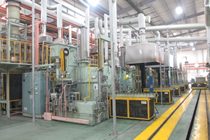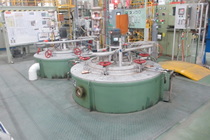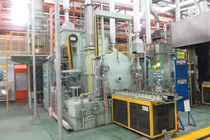-

Carburizing
In this treatment, the processed metal (especially low-carbon steel) absorbs carbon so that its surface is hardened. This results in a product with a hard surface and high resistance to abrasion, while the inside is soft and ductile.
-

Carbonitriding
Carbonitriding is a method of carburizing where the metal absorbs nitrogen simultaneously with carbon, and then the surface is hardened. In general, this treatment is conducted using the same facilities as gas nitriding.
-

Gas nitriding
In gas nitriding, the metal absorbs nitrogen when a nitrogen-rich atmospheric gas comes in contact with its surface. It gives high resistance to abrasion. This treatment began when Dr. Fry presented his method of decomposing NH3 in 1923. Many surface-hardening methods including gas soft-nitriding and ion nitriding have been introduced since then, but if a thicker hard layer is desired, gas nitriding is the best way. This company has developed many gas nitriding furnaces on its own.
-

Gas soft-nitriding
Gas soft-nitriding is used to modify surfaces of thin parts used in automobiles, hydraulic equipment, electronic equipment, etc. Using gas from generators as well as nitrogen gas and ammonia gas, gas soft-nitriding adds nitrogen and carbon to the surface of materials. Ideal when requiring resistance to abrasion, fatigue and corrosion (resistance to corrosion is equivalent to the level from galvanizing to chrome plating).